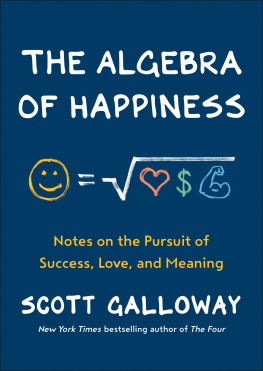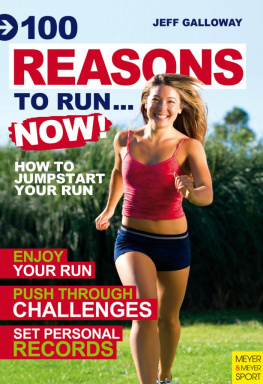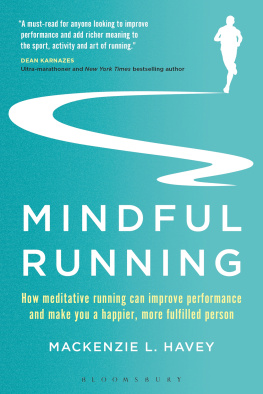
Jeff Galloway
Mental Training for Runners
No More Excuses!
Meyer & Meyer Sport (UK) Ltd.

Contents
Imprint
2016 by Meyer & Meyer Sport (UK) Ltd.
Aachen, Auckland, Beirut, Cairo, Cape Town, Dubai, Hgendorf, Hong Kong, Indianapolis, Manila, New Delhi, Singapore, Sydney, Teheran, Vienna
Member of the World Sport Publishers Association (WSPA)
978-1-78255-413-4
www.m-m-sports.com
ISBN 978-1-78255-413-4
Foot Notes
Pert, C. 1997. Molecules of Emotion. New York: Scribner, 188.
Ibid, 352-353.
Ibid, 148.
Bruce Lipton, PhD, from the foreword to Marie, N. 2004. Passage of Change. Phoenix: Inner Eye Publishing
Pert, C. 1999. Molecules of Emotion, New York: Scribner, 277.
Sarno, J.E. 1998. The Mindbody Prescription. New York: Wellness Central.
Bruce Lipton, PhD, from the foreword to Marie, N. 2004. Passage of Change. Phoenix: Inner Eye Publishing
Pert, C. 1997. Molecules of Emotion. New York: Scribner.
Lipton , B. 2005. Biology of Belief. Carlsbad: Hay House, Inc., 103.
Peeke, P. 2013. The Hunger Fix. Emmaus: Rodale Books
Pert, C. 1997. Molecules of Emotion. New York: Scribner, 148.
Lipton, B. 2005. Biology of Belief. Carlsbad: Hay House, Inc., 135.
The contents of this book were carefully researched. However, all information is supplied without liability. Neither the author nor the publisher will be liable for possible disadvantages or damages resulting from this book.
INTRODUCTION
Your Inner StrengthBelieve In It!
You have within yourself the power to overcome low motivation on the lowest energy days and the power to keep going when there are challenges. By using the proven strategies in this book you can also make permanent nutrition changes, manage stress, and maintain control over fatigue and injury.
Youll also learn how neuroscientists have found that distance running stimulates the growth of new brain cells and improves thinking and learning at any age. Even after a few running steps, brain circuits are turned on for a better attitude, more vitality, and personal empowerment.
We now have proof that running transforms the brain in many positive ways. Revolutionary research begun in the 1990s, made possible by new technology, identified the brain circuits that are turned on when we run. These circuits trigger the release of brain hormones that balance emotions, enhance problem solving, and help us to make better decisions.
With the help of my wife Barbara, who wrote the foreword to this book, Ive discovered nuggets of research that explain why some runners stay motivated and some do not, why some perform well and others do not, and why some enjoy their training and others take it like medicine. Leading researchers you will read about in this book are the following:
Neuroscientist John Ratey, MD, in his breakthrough book Spark, explains how exercise activates key circuits and stimulates brain hormones that grow brain cells and improve mental function.
Scientists Candace Pert, PhD, and Bruce Lipton, PhD, explain the biological and molecular changes that allow us to control our emotions and reformat negative behavior patterns in the subconscious.
John Sarno, MD, has shown that stress can trigger negative hormones and a pain responsewith management techniques.
Robert Portman, PhD, and John Ivy, PhD, detail the brain circuits involved in eating behaviors with ways of gaining control.
For four decades, Ive been researching, trying motivational strategies, tabulating results, and learning from experience. The ideas inside are the latest evolution of a method that has been practiced successfully by thousands. I offer these as one runner to another based upon the success of my clients. As always, seek medical advice for health issues from those who specialize in the area of your issueespecially someone who wants to find a way for you to continue running.
You can do it!
Jeff Galloway
FOREWORD
To Be Happy, Joyous, and Confident
By Barbara Galloway
When Jeff told me that he was writing a book on motivation, my first thought was, for what do you want to be motivated? Most runners have several or several dozen reasons to be and stay motivated. For me, the answer is in the title of this preface. I want to be happy, joyous, and confident.
The late Dr. George Sheehan, cardiologist, philosopher, and Runners World columnist often quoted Emerson who told us to Be first a good animal. There is a lot of satisfaction when we follow our most natural patterns of exertionto move, walk, and run. At a fast pace there are more aches, pains, and fatigue. But when you choose a relaxing pace, with the right balance of running and walking, you can be a good, happy, and joyous animal.
I believe Emerson was telling us that we have within ourselves all that we need for happiness. By using our body regularly, which engages our mind and spirit, we improve quality and longevity. Positive things happen when we are first and foremost good, active animals.
For many years, this has been my ultimate motivation. But, like many experiences in life, running begs us to dig deeper. I have made it a mission to search for ideas that can enhance motivation to exercise and to share these with Jeff. The ideas presented in this book have enriched our running experiences, and I hope that you will experience similar benefits.
Im not going to stop looking and reading. There are so many great ideas, experiences, and opportunities out there.
Get motivated, stay motivated.
Barbara Galloway
PREFACE
Taking the Puking Out of RunningMy story
At the age of 13, I was a very overweight, lazy kid. I wasnt proud of being fat, and I realized that exercise could be a key to losing my extra baggage. But in my internal priority list, rated above being lean was the avoidance of exercise. I now know that I had programmed myself to believe that it hurt because of some puking incidents after being pushed too hard by a PE coach who wanted to help me get in shape.
Then I enrolled in a school that required male students to engage in strenuous activities or sports after school. Generally, Im not a fan of forcing kids to exercise, but it worked for me because of the spontaneous fun that emerged from almost every run with the cross-country team. The head coach, Paul Koshewa, was the most lenient in the school and allowed us options. I initially joined a group of lazy kids who would jog 200 yards to the woods and goof off.
But one day, an older kid who I liked said, Galloway, youre coming with us today. My anxiety soared because these kids actually ran long distances3 miles! I had my lazy boy strategy in place: When I reached the protective cover of the woods I would grab my leg, claim I was injured, and throw rocks in the creek as they ran on. But the runners started telling jokes and then gossip about the teachers. I listened at first, huffing and puffing. With a little more fitness I began to participate in the conversations. We shared stories, argued, and more than anything else, enjoyed the fun environment that we created each day.
Within 10 weeks I was hooked on the endorphin experience, and over half a century later, I still am. My grades significantly improved. I discovered that even when things had not been going well at school or personally, the workout with my group turned my attitude around. The bonding resulted in honest friendships based upon mutual respect that have lasted to this day.











